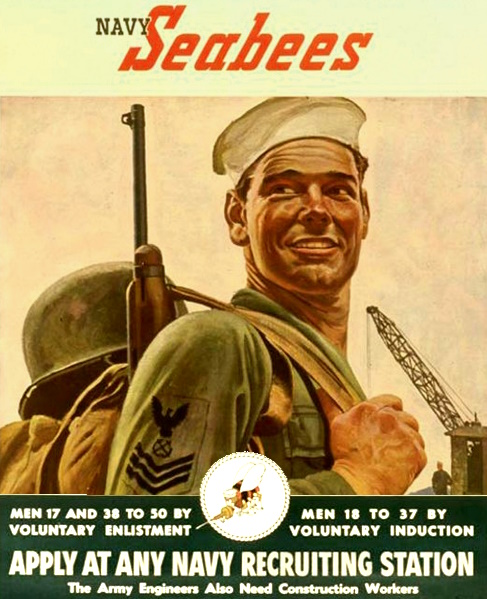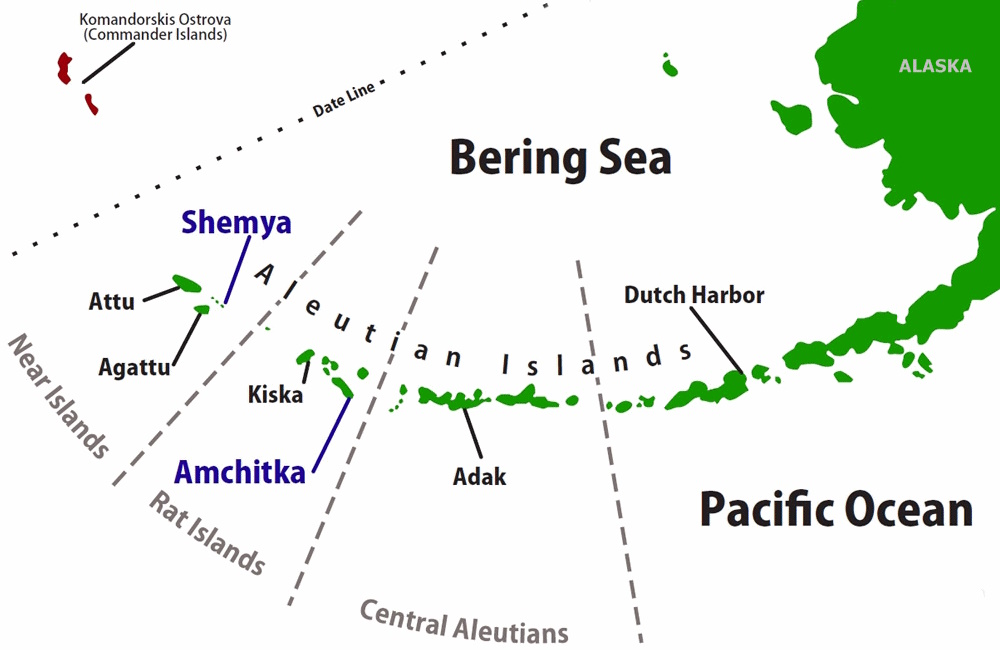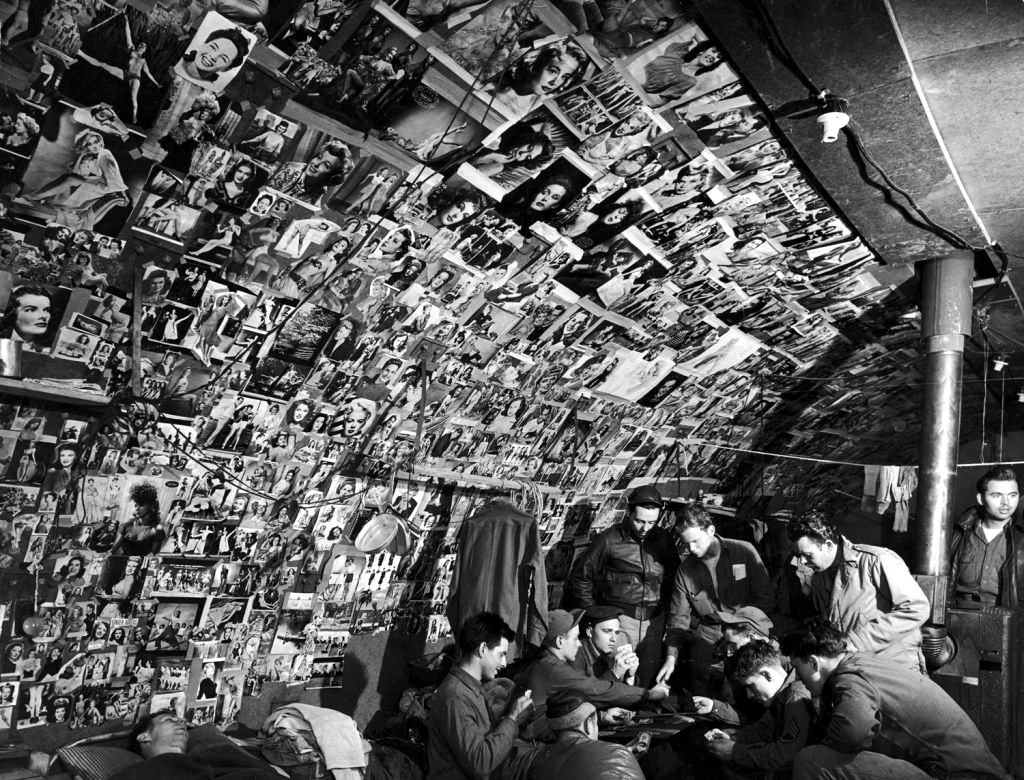Document Source: Log Book of the 85th Naval Construction Battalion & History (EUCMH Archives)
 85th Naval Construction Battalion
85th Naval Construction Battalion
February 6, 1943. Following in the footsteps of the 84 Groups ahead of them, 27 officers and 1079 enlisted men who had been through an initial three weeks training period, paraded in ceremonial review and also the thick mud of Virginia, with the group officially named the 85th US Naval Construction Battalion and the battalion standard presented to the Officer in charge, Commander Frederick C. Ray, by Commander A. G. Hillberg, CEC, USNR, who was the Military Training Officer at Camp Allen (Texas), and Camp Bradford (Virginia).
February 8, 1943. Entrained for a six weeks period of advance training at Camp Endicott, Davisville, (Rhode Island), after crossing the Chesapeake Bay from Little Creek to Cape Charles on the streamlined ferry, Princess Anne, with the cocktail bar secured for the trip.
February 9, 1943. Arrived at Camp Endicott on a clear cold day and assigned to barracks. The succeeding two months were filled with specialized courses, including judo, commando tactics, chemical warfare, rifle marksmanship, machine gun, and long hikes. The officers and chiefs had a week of training under Marine Lieut. Collins. A fire destroyed BOQ and most of the officers suffered the loss of their clothing and other personal effects. The worst weather in ten years was experienced, with the thermometer more than twenty degrees below zero. A personnel inspection by Capt Rogers resulted in his comment to the effect that, the 85th represented the neatest and cleanest battalion it has been my privilege to review, and on April 5, our Battalion was part of the parade reviewed by Secretary of the Navy Knox. Many other experiences at this base, and last but not least, the hospitality displayed by the people of Rhode Island and the high times at the Biltmore and Narragausett and Crown and the Chinese Clipper and Port Arthur.
April 13, 1943. In three sections the Battalion departed for Camp Holliday, Gulfport, (Missouri), with no extraordinary developments experienced on the trip.
April 16, 1943. Dirty and tired from two days and three nights in day coaches, two sections arrived at Camp Holliday just after dawn, and the character and initiative of the commissary were evidenced by their ability to furnish an excellent breakfast within an hour’s time. Shortly before midnight, the third section of the Battalion arrived on the base.
April 17, 1943. Ninety percent of the Battalion, officers included, stormed the little town of Gulfport with leave papers in hand and the determination to be the first aboard any train heading in the direction of home, causing the city fathers no little consternation and a call to the Camp for reserves to quell the near riot. Eventually, sufficient trains, busses, and taxis were called into service and the town receded to its customary quiet tempo, but not without a deep and lasting recollection of the 85th.
May 1, 1943. Again in three sections, the Battalion embarked on a five-day train trip to Camp Rousseau, Port Hueneme, (California), which proved uneventful, except for one man who debarked, leaving the train for parts unknown, and another who was taken off in New Mexico with an attack of appendicitis. One section arrived in the camp nearly a full day ahead of the rest of the others and did much toward getting living conditions in hand for the balance of the Battalion which arrived after midnight.
May 6, 1943. At Camp Rousseau, the remaining 10 percent of the Battalion took their embarkation leaves, while those staying aboard received an issue of carbines, foul weather gear, gas masks, etc. Baker Co was detached to form the separate 509th Beach Master Unit under command of Lt Neidelmann, and the last two days in camp found the men restricted to the battalion area.
May 20, 1943. Camp Rousseau was left with a degree of mixed feelings, for it represented the last permanent residence in this country, and what the future held in store was as yet a mystery. Again the train trip was without incident, with the exception of another man who decided the scenic beauties of Oregon were irresistible and decamped without thought of the consequences.
May 22, 1943. Early morning found the Battalion within the confines of the inner harbor of Seattle. Following a box lunch for breakfast, and before noon, all were safely quartered in the holds of the USS Chaumont. Space was utilized to the nth degree, and probably for the first time in their lives, those from Texas could sympathize with the steers they’d herded into cattle cars in years gone by. Even the officers were somewhat dismayed by the cramped space in their staterooms.
May 23, 1943. One-half of the Battalion was granted liberty until midnight with word to the shore patrol to pass men in undress blues and GI shoes – a sight which took Seattle slightly by surprise. Those involved enjoyed the release and were loud in their praise of the city’s virtues and beauty, which did in no manner add to the pleasure of the rest of the men when informed that liberty for them had been canceled.
May 25, 1943. At 0900, the USS Chaumont slipped from her dock and headed out through Puget Sound, with a short stop for lifeboat drill and then later in the day, target practice with the three-inches, creating a wave of excitement for the men. The rest of the trip was without incident, except for the USO performances, the antiaircraft practice with the ship’s Oerlikons, and the sight of the 1st whale. Unforgettable was the almost continuous chowline, eating below decks without the benefit of seats, and the ship’s Master-at-Arms who so considerately kept his voice to only a bellow when calling mess detail in the early morning hours.
May 30, 1943. The afternoon found the ship at an increased tempo of rolling, pitching, and bucking, much like a restive horse fighting the bit. As the hours passed an occasional glimpse of jagged rock, marking the coastline was discerned through the deep fog, and at about 1930 the quiet waters of Dutch Harbor were entered. By 2000 the ship had been docked, with the transfer of men and personal gear beginning immediately. It must have been at this particular moment, that the scuttlebutt of the Battalion’s being home by Christmas, was started.
June 1, 1943. The big task of understanding the operations of the base and assigning the men to jobs was begun, and it was a week or more before the Battalion hit its full stride as a working unit. Meanwhile, permanent quarters were established for the men, and improvements in living conditions and sanitary facilities were completed as fast as possible.
June 13, 1943. The first casualty of the Battalion cast its somber shadow over the men, with the death of John Q. Green, while in the line of duty. Emotions were released somewhat by the voluntary and generous contribution to a fund for the widow and three children.
June 15, 1943. Another disheartening blow was when the death of Donald C. Jolley, who had suffered a short illness, was reported. Again the men responded freely in contributing for the benefit of the widow and two children.
June 21, 1943. Our first practice alert began at 0430, with several hours spent in the wet, cold, and muddy foxholes. Realistic and impressive with the planes taking off the field to intercept enemy bombers, the chemical machines belching artificial fog, and the light touch of tear gas which was sprayed about the foxholes.
July 4, 1943. It was recalled that this day was being celebrated in the States, with a surcease from work, picnics, and other social gatherings. No such luck on Island X.
August 7, 1943. The first of a series of personnel inspections was held by the Base Commandant, Capt C. W. Crawford, with half the Battalion participating.
August 20, 1943. Lt Comdr Frederick C. Ray was advised of his appointment to that of Commander, and Lt Thomas J. Lewis was informed of his appointment to Lt Comdr.
September 8, 1943. Experienced the first williwaw of the season, finding it not nearly as bad as pictured. Some slight damage to living quarters and other buildings. (Note: In meteorology, a williwaw is a sudden blast of wind descending from a mountainous coast to the sea. The word is of unknown origin but was earliest used by British seamen in the 19th century. The usage appears for winds found in the Strait of Magellan, the Aleutian Islands, and the coastal fjords of the Alaskan Panhandle, where the terms outflow wind and squamish wind are also used for the same phenomenon. In Greenland, the word piteraq is used. The williwaw results from the descent of cold, dense air from coastal mountains in high latitudes. Thus the williwaw is considered a type of katabatic wind).
October 25, 1943. Commander Ray was transferred from the Battalion, and Lt Comdr T. J. Lewis appointed Officer-in-Charge.
October 27, 1943. Reveille changed from 0500 to 0600 and chow from 0515 to 0615; heartily welcomed by all concerned.
November 1, 1943. Two hundred sixty men under the direction of four officers, with Lt Julian R. Fleischmann as Officer-in-Charge, were taken aboard and installed as Baker Co of the 85-NBC.
November 11, 1943. A day of celebration in the States, but just another work-day in the Aleutians. (Note: Aleutian Islands, Aleut: Unangam Tanangin, ‘Land of the Aleuts’, possibly from Chukchi aliat, ‘island’, also called the Aleut Islands or Aleutic Islands and known before 1867 as the Catherine Archipelago, are a chain of 14 large volcanic islands and 55 smaller islands. Most of the Aleutian Islands belong to the US state of Alaska, but some belong to the Russian federal subject of Kamchatka Krai. They form part of the Aleutian Arc in the Northern Pacific Ocean, occupying a land area of 6,821 sq mi (17,666 km2) and extending about 1200 mi (1900 km) westward from the Alaska Peninsula toward the Kamchatka Peninsula in Russia, and act as a border between the Bering Sea to the north and the Pacific Ocean to the south. Crossing longitude 180°, at which point east and west longitude end, the archipelago contains both the westernmost part of the United States by longitude (Amatignak Island) and the easternmost by longitude (Semisopochnoi Island). The westernmost US island in real terms, however, is Attu Island, west of which runs the International Date Line. While nearly all the archipelago is part of Alaska and is usually considered as being in the Alaskan Bush, at the extreme western end, the small, geologically related Commander Islands belong to Russia. The islands, with their 57 volcanoes, form the northernmost part of the Pacific Ring of Fire. Physiographically, they are a distinct section of the larger Pacific Border province, which in turn is part of the larger Pacific Mountain System physiographic division. The islands are considered to be among the most geographically isolated areas in the North Pacific).
November 12, 1943. Lt W. E. Pantle was assigned the position of Executive Officer, and Ensign R. H. Kemter arrived to assume the duties of Lt (jg) Hartje who was detached from the Battalion for return to the States.
November 18, 1943. An alert that lasted two hours, with all men in foxholes.
November 25, 1943. Thanksgiving Day and the Navy furnished a bountiful dinner, supplemented by candy, cigarettes, and cigars from the Welfare Fund. Work as usual.
December 7, 1943. Pearl Harbor Day with War Bonds purchased, exceeding the quota by 66 percent.
December 22, 1943. A crew of 22 men direct from the States, was received aboard.
December 25, 1943. Christmas Day. For the majority, it is the first away from home. Work was secured and a special dinner was furnished by the commissary, with smokes and candy from welfare. A theatre had been commandeered and a special program was given to the men, including the presentation of War Bonds as prizes.








